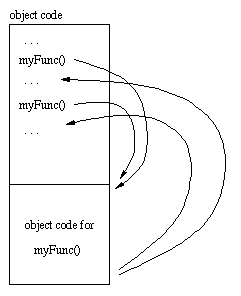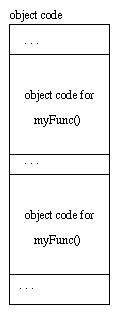

|
CMPT 212
Spring 1998
|
// shape.h
class rectangle {
public:
void setSize(int x, int y);
int getWidth();
int getLength();
private:
int width;
int length;
}; // <-- Note the semicolon.
// main.cpp
#include
#include "shape.h"
int main() {
rectangle a;
rectangle * b = NULL;
a.setSize(5, 12);
cout << a.getWidth();
b = new rectangle;
(*b).setSize(3,4); // These two lines do
b->setSize(3,4); // the same thing.
cout << b->getLength();
return 0;
}
// shape.cpp
#include "shape.h"
void rectangle::setSize(int x, int y) {
width = x;
length = y;
}
int rectangle::getWidth() {
return width;
}
int rectangle::getLength() {
return length;
}
// shape.cpp
#include "shape.h"
int getWidth() {
return screenWidth; // Assume screenWidth is previously defined.
}
int rectangle::getWidth() {
return width;
}
void rectangle::maximizeWidth() {
width = ::getWidth();
}


inline int myFunc(char c);

Return to lecture notes index |
|
| This page is maintained by simpson@cs.sfu.ca. | Last updated on 4 Feb 1998. |